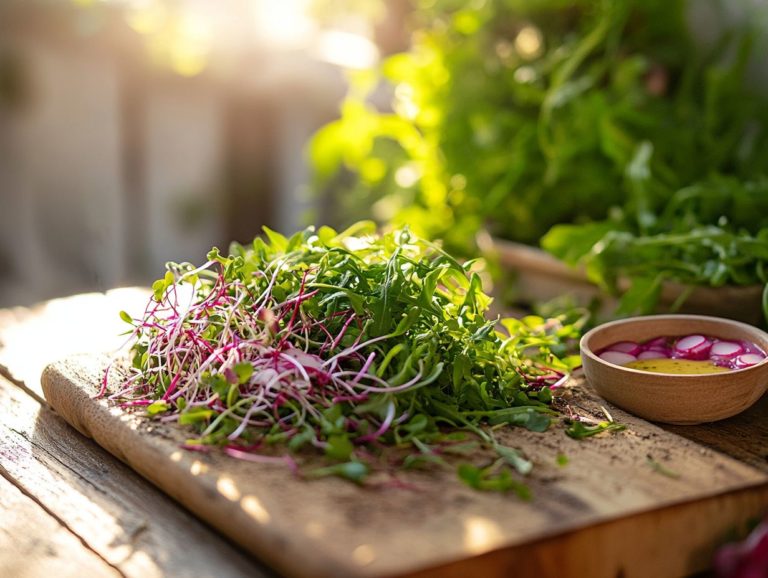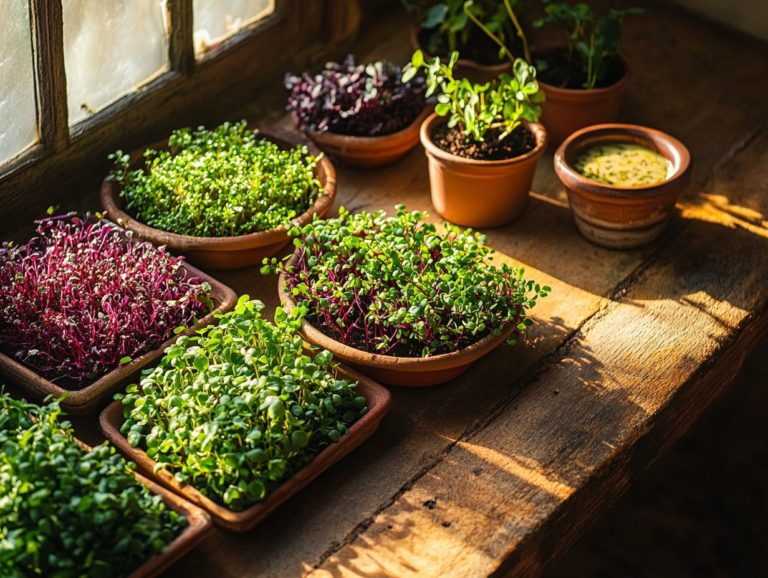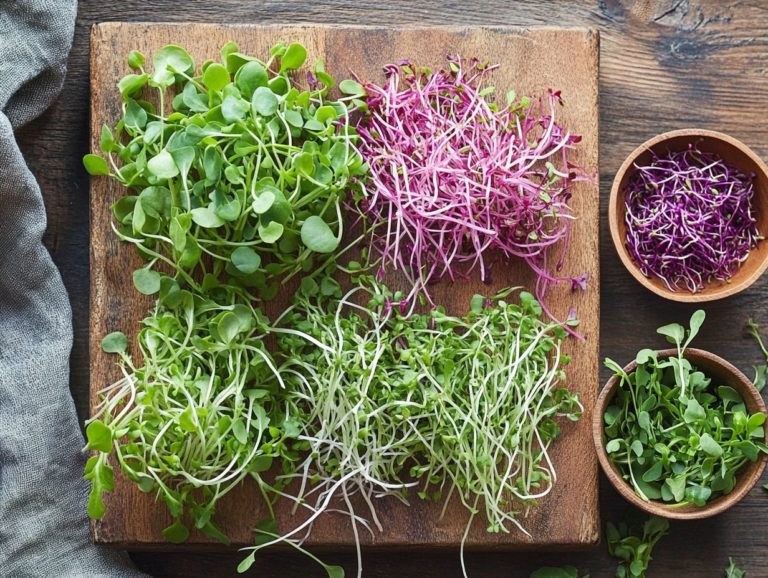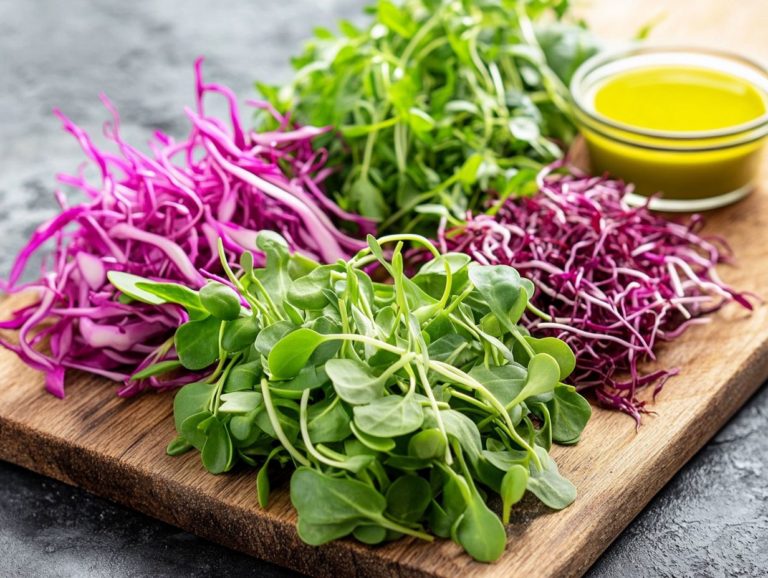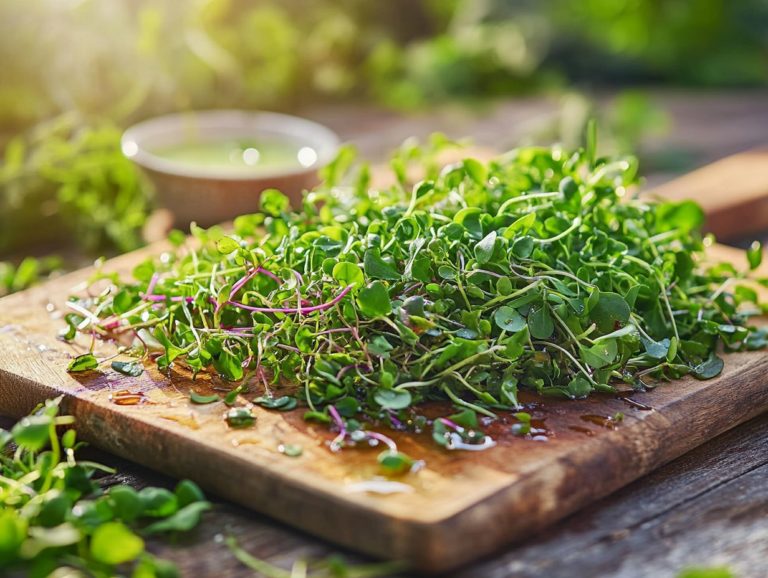The Science Behind Microgreens and Health
Imagine tiny powerhouses of nutrition packed into your meals! Microgreens are vibrant, nutrient-dense plants that bring remarkable benefits to your health and nutrition. These greens not only enhance the flavor of your meals but also pack an impressive array of vitamins and minerals.
This article delves into what microgreens are and highlights their nutritional advantages over mature plants. You ll also find creative ways to incorporate them into your diet, practical tips for growing your own, and guidance on selecting the best varieties to align with your health goals.
Explore how these little greens can create a significant impact on your well-being!
Contents
- Discover the Amazing Health Benefits of Microgreens
- Health Benefits of Microgreens
- How to Incorporate Microgreens into Your Diet
- Growing Your Own Microgreens
- Choosing the Right Microgreens for Your Health Goals
- Frequently Asked Questions
- What are microgreens and why are they considered healthy?
- Discover the Science Behind Microgreens and Their Amazing Health Benefits!
- How do microgreens compare to fully grown vegetables in terms of nutrition?
- Can microgreens help with weight loss?
- Are there any specific health benefits associated with certain types of microgreens?
- How can I incorporate microgreens into my diet for maximum health benefits?
Key Takeaways:
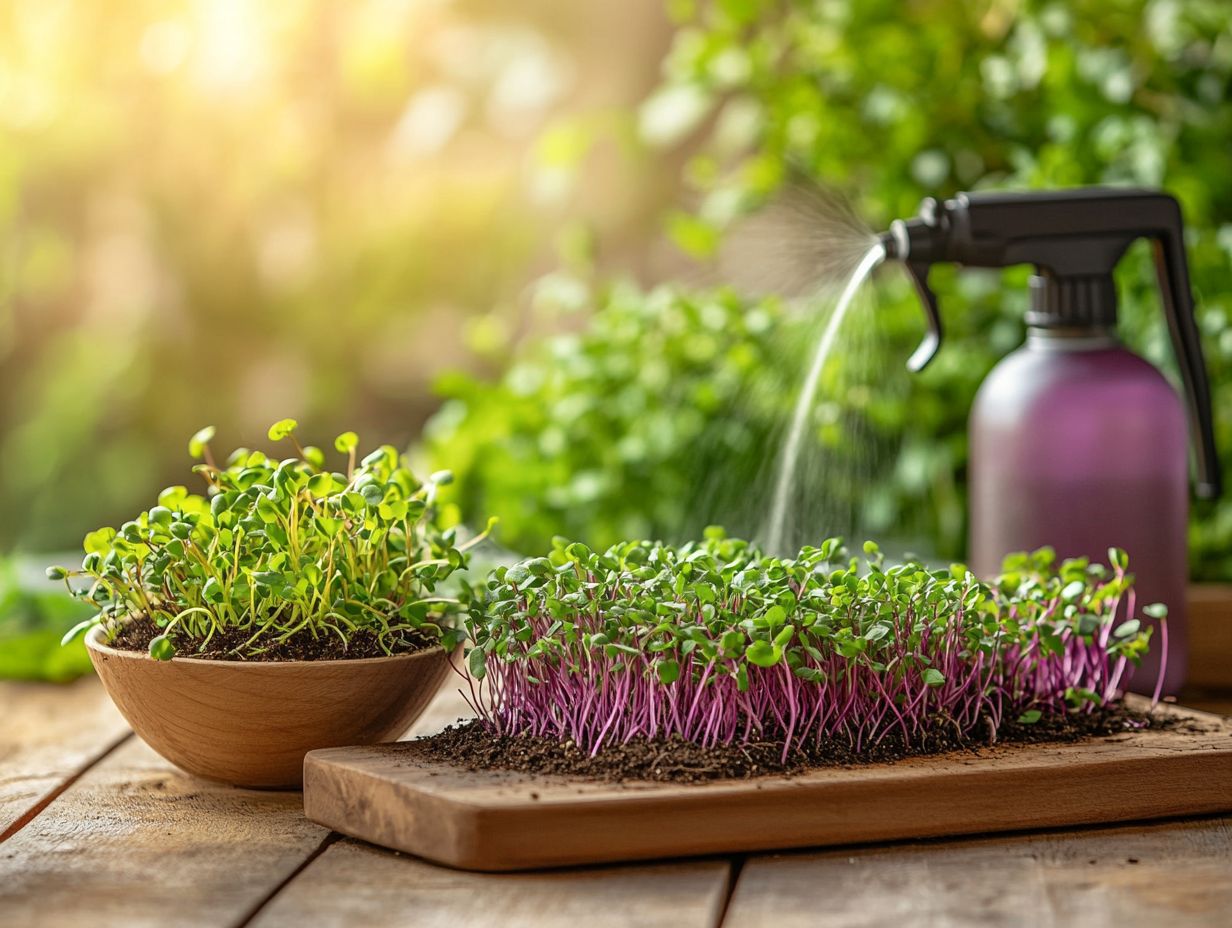
- Microgreens are young and tender plants packed with nutrients, making them a healthy addition to any diet.
- Research has shown that microgreens contain higher levels of nutrients compared to their mature counterparts, making them a superior choice for health benefits.
- There are many creative and delicious ways to incorporate microgreens into your diet, and growing them at home is easy and cost-effective.
What are Microgreens?
Microgreens, those delightful young vegetables and herbs harvested just after their first true leaves emerge, are a treasure trove of flavor, vibrant colors, and cooking flexibility. They are a favored choice for the health-conscious.
You can effortlessly incorporate these nutrient-rich greens into salads, sandwiches, and garnishes. They add not only a boost in nutritional value but also a stunning visual element to your dishes.
Renowned for their concentrated nutrients and sustainability, microgreens embody an innovative approach to urban farming and healthy eating. They captivate anyone eager to elevate their plant-based diet.
Definition and Characteristics
Microgreens are essentially the young seedlings of edible vegetables and herbs, typically harvested just after the first true leaves emerge. They provide a concentrated burst of nutrients.
These petite greens are not only a feast for the eyes; they also deliver an impressive variety of flavors and textures. For example, you’ll find that broccoli microgreens offer a slightly peppery kick, while kale microgreens bring a robust, earthy essence, perfect for elevating your culinary creations. Additionally, understanding microgreens and their health advantages can enhance your appreciation of these greens. Spinach microgreens, in contrast, lend a delicate, fresh touch that pairs beautifully with salads and smoothies.
They grow quickly and effortlessly, thriving in either soil or hydroponic systems, as long as they receive ample sunlight and moisture.
These culinary gems fit seamlessly within the broader vegetable family, showcasing both their nutritional benefits and their adaptability in a myriad of recipes.
Nutritional Value of Microgreens
Microgreens are revered for their remarkable nutritional prowess. They frequently boast higher levels of vitamins, minerals, and phytonutrients than their fully grown counterparts.
For those who prioritize health, these tiny greens truly embody the essence of a superfood.
Comparing Nutrient Levels to Mature Plants
When you compare the nutrient levels of microgreens to those of mature plants, you’ll find that microgreens can boast up to 40 times more nutrients, including essential vitamins and antioxidants.
This remarkable nutrient density not only elevates your diet but also underscores their potential benefits for improving your health markers. The higher amounts of vitamins C and E in these young greens are renowned for their ability to bolster your immune system and act as potent antioxidants, as highlighted in our article on understanding the antioxidant capacity of microgreens.
Additionally, the increased concentration of polyphenols and other beneficial compounds can assist in managing insulin resistance and optimizing cholesterol levels.
Incorporating microgreens into your daily meals could be a powerful strategy for enhancing your overall nutritional intake. Don t miss out on adding these vibrant greens to your meals today; they re just a step away!
Discover the Amazing Health Benefits of Microgreens
Health Benefits of Microgreens
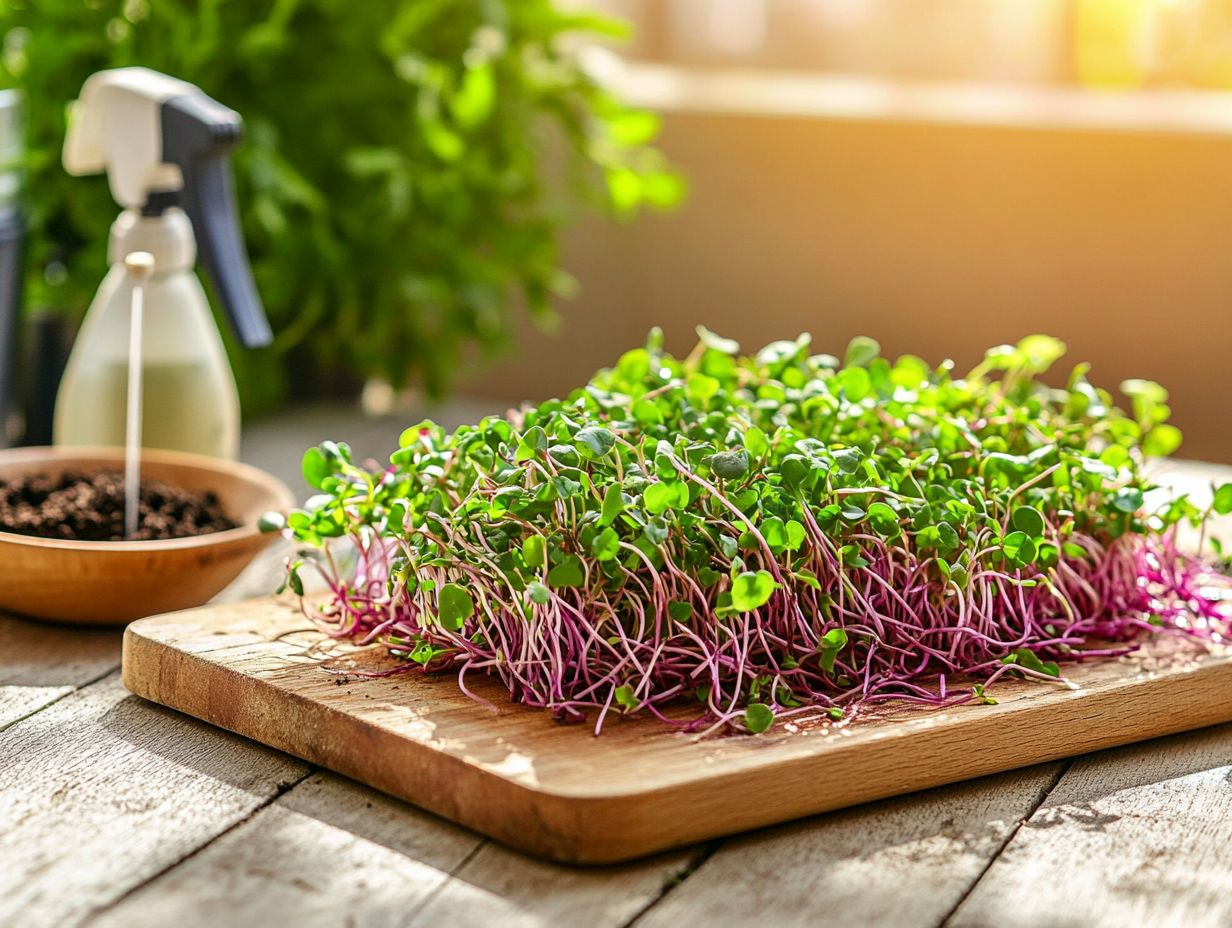
The health benefits of microgreens are extensive. They offer various physiological advantages that can elevate your well-being.
You ll find that these tiny powerhouses enhance disease prevention, promote improved gut health, and boast significant antioxidant properties all of which work together to combat chronic diseases and support your overall wellness.
Research and Evidence
A growing body of research underscores the impressive health benefits of microgreens. They hint at their potential to mitigate risks associated with chronic conditions such as Alzheimer s disease and iron deficiency due to their remarkable antioxidant properties.
These diminutive greens, including broccoli and kale sprouts, are brimming with vitamins, minerals, and phytochemicals. These nutrients can substantially enhance cognitive function and bolster metabolic health.
In numerous studies, participants who incorporated microgreens into their diets demonstrated improved memory and attention spans. They also experienced significant reductions in inflammation and oxidative stress.
The elevated concentrations of specific antioxidants within these plants have been associated with enhanced insulin sensitivity, playing a role in managing metabolic diseases. As researchers delve deeper into these promising connections, the future shines brightly for microgreens as a simple yet powerful addition to your diet for overall wellness. Discover more about unlocking the antioxidant power of microgreens.
How to Incorporate Microgreens into Your Diet
Incorporating microgreens into your diet is not only simple but immensely rewarding. These tiny powerhouses not only boost the flavor but also supercharge the nutrition of your favorite dishes, from crisp salads to refreshing smoothies.
They truly are a versatile addition to any health-conscious menu.
Creative and Delicious Ways to Enjoy Microgreens
There s an abundance of creative and delicious ways for you to enjoy microgreens. You can sprinkle them atop your favorite sandwich, blend them into smoothies, or use them as a vibrant garnish for soups and salads.
These tiny greens pack a powerful punch, elevating dishes like bruschetta with their zesty flavor or adding a refreshing bite to hearty grain bowls. Imagine adding pea shoots to a rustic quiche for a delightful twist on a classic recipe. You can also mix radish microgreens with avocado to create a spread that s both creamy and peppery.
Their versatility invites experimentation. Consider tossing sunflower microgreens with citrus vinaigrette for a bright side salad that invigorates your palate. With impressive nutritional benefits rich in vitamins and antioxidants, why microgreens are superfoods enable you to explore various varieties, allowing you to craft personalized, health-conscious meals that delight the senses.
Growing Your Own Microgreens
Cultivating microgreens at home is not only an accessible venture but also a gratifying one that embodies sustainable food practices. Get ready to enjoy fresh, nutrient-rich produce right from your kitchen!
Tips and Techniques for Home Cultivation
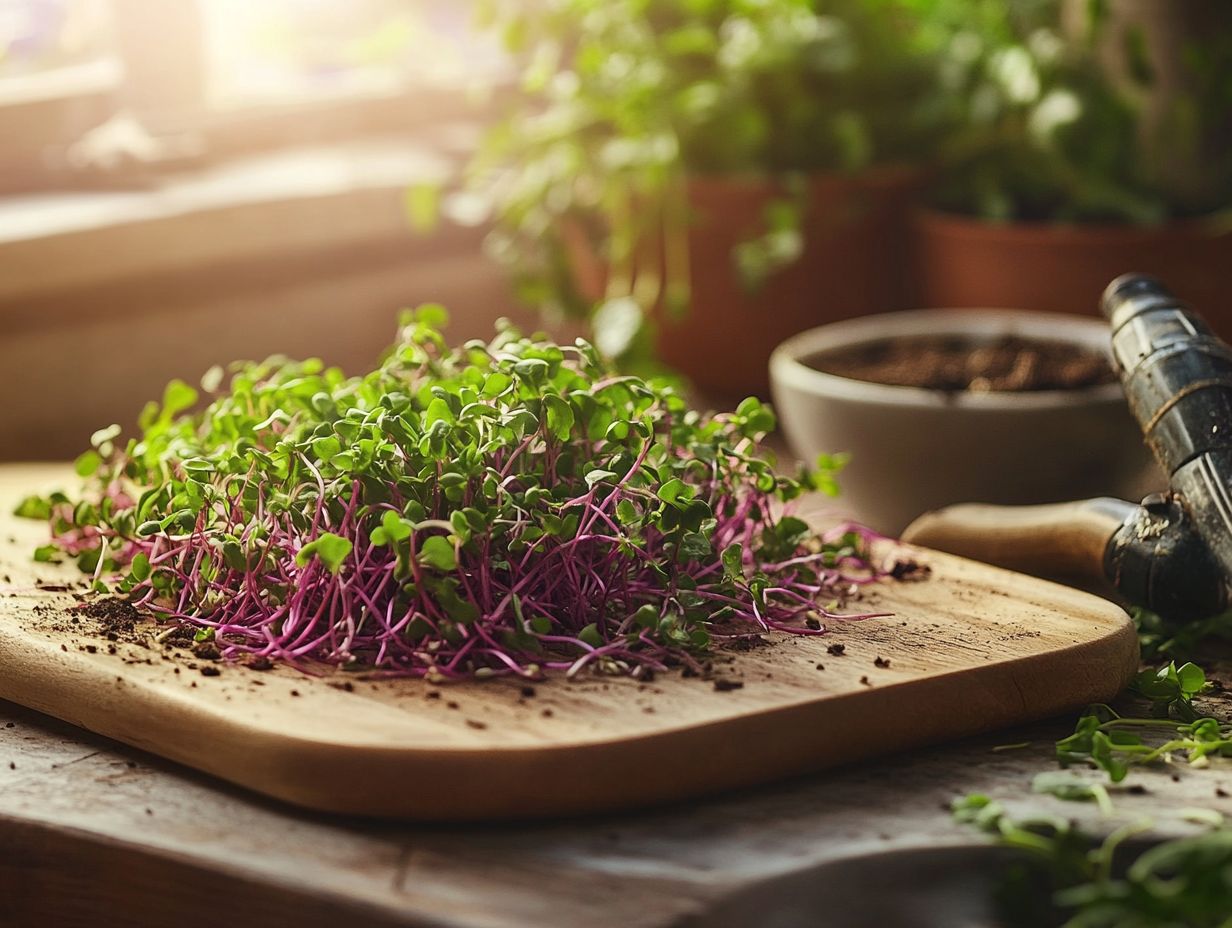
To successfully cultivate microgreens at home, you need to grasp the ideal growing conditions. Key aspects include light, water, and soil.
- Follow important food safety practices to ensure a safe harvest.
- A well-ventilated space with ample natural sunlight or suitable grow lights is essential.
- Microgreens flourish in warm environments, with temperatures consistently between 65 F and 75 F for optimal germination.
- Selecting high-quality seeds is equally vital; choose organic or untreated varieties for safer and more flavorful greens.
Regularly checking moisture levels is crucial to ensure the soil stays damp but never waterlogged. Overwatering can invite mold and mildew.
Practicing good hygiene like washing your hands before handling crops and sanitizing surfaces will elevate food safety throughout the growing process.
Choosing the Right Microgreens for Your Health Goals
Selecting the right microgreens that align with your health goals can truly enhance your diet. Each variety of microgreen brings its own unique benefits, whether it s boosting antioxidant levels, improving gut health, or supporting a plant-based lifestyle.
Popular Varieties and Their Benefits
Popular microgreen varieties like broccoli, kale, spinach, and amaranth are not just delicious; they also bring a wealth of health benefits to your plate, making them excellent additions to a nutrient-rich diet.
Each vibrant green offers unique advantages that significantly enhance your overall well-being. Broccoli microgreens are brimming with sulforaphane, a compound celebrated for its potential cancer-fighting properties. Kale microgreens serve up a powerful punch of vitamins A, C, and K, essential for bolstering your immune system and maintaining radiant skin. For health enthusiasts, the top microgreen varieties like spinach microgreens are your go-to for an energy boost, thanks to their high iron content perfect for shaking off fatigue.
Meanwhile, amaranth packs a notable amount of protein and antioxidants, which support cognitive function and sharpen mental clarity. The flavors of these microgreens are just as varied: broccoli offers a slightly peppery taste, kale presents a robust, earthy profile, spinach is mild and refreshing, while amaranth adds a hint of subtle sweetness. Incorporating these greens into your diet can illustrate why microgreens are essential for a balanced diet.
This versatility makes them suitable for a range of culinary creations, from vibrant salads to energizing smoothies and elegant garnishes.
Frequently Asked Questions
What are microgreens and why are they considered healthy?
Microgreens are tiny edible plants that are harvested when they are only a few inches tall. They re bursting with nutrients and antioxidants, making them a healthy addition to any diet, especially for those focusing on health-promoting diets and nutrient-rich food sources.
Discover the Science Behind Microgreens and Their Amazing Health Benefits!

Packed with vitamins, microgreens are a powerhouse of nutrition. They also contain a concentrated amount of plant compounds, which are beneficial compounds found in plants that have been linked to health benefits.
How do microgreens compare to fully grown vegetables in terms of nutrition?
Studies have shown that microgreens can contain up to 40 times more nutrients than their fully grown counterparts. This is due to their small size and rapid growth, which allows them to absorb and concentrate more nutrients, making them superfoods with high antioxidants and nutrient concentrations, ideal for healthy eating.
Can microgreens help with weight loss?
Microgreens are low in calories but high in nutrients, making them a great addition to a weight loss diet. They also contain fiber, which can help you feel fuller for longer and prevent overeating.
Are there any specific health benefits associated with certain types of microgreens?
Different types of microgreens have varying levels of nutrients and antioxidants, so the specific health benefits may vary. For example, red cabbage microgreens are high in vitamin C and may help boost the immune system, while broccoli microgreens contain sulforaphane, which has been linked to anti-cancer properties.
Try adding microgreens to your next salad or smoothie and experience the health benefits for yourself!
How can I incorporate microgreens into my diet for maximum health benefits?
You can easily add microgreens to any meal. These tiny greens are powerhouses of nutrition!
Add them to salads, sandwiches, smoothies, or use them as a garnish. Just remember to wash them thoroughly before consuming. Start incorporating these healthy greens today for a delicious boost to your meals!

